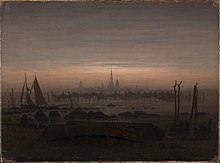Nocturne
![]()
Notturno is a redirect to this article. For other meanings, see Notturno (disambiguation).
![]()
This article or subsequent section is not sufficiently supported by evidence (e.g., anecdotal evidence). Information without sufficient evidence may be removed in the near future. Please help Wikipedia by researching the information and adding good supporting evidence.
No evidence is given for the description and little for the examples --Babarr (discussion) 10:24, 11 Nov 2017 (CET)
The nocturne (also: "the") or nocturne (literally: "becoming night", usually: "nocturnal") is a musical form that originated in the Baroque period and is not fixed in its instrumentation and movement structure. During this period, the term nocturne overlapped with serenade. Nocturnes established themselves as entertainment music at princely houses and were primarily instrumental, but could also contain vocal elements.
In today's perception, however, the nocturne is primarily associated with character pieces for piano composed during the Romantic period, the inventor of which is the Irish composer John Field. Frédéric Chopin's 21 Nocturnes, which rarely correspond to the image of the nocturne as a rather slow and quiet piano piece valid at that time, but rather unfold a great variety of expressive possibilities, have gained special significance. The likewise very popular Liebesträume by Franz Liszt correspond more closely to these ideas, although they require a high degree of technical skill on the part of the performer.
Nocturnes for piano were also composed by Alexander Scriabin (under the strong influence of Chopin), Erik Satie, Gabriel Fauré and Sergei Rachmaninoff, among others.
Claude Debussy composed nocturnes for orchestra and choir again in Impressionism. Billy Joel used the nocturne in popular music.
Volker David Kirchner wrote a concert piece for viola and orchestra with the German expression for nocturne in the title: Nachtstück (variations on a Wagnerian chordal connection).

The "nocturnal" was also rediscovered in the visual arts of the Romantic period. Caspar David Friedrich created many nocturnal views, here in 1817 the view of Greifswald in the moonlight.

John Field around 1835
Examples
- John Field:
- Nocturne No. 1 in E flat major for piano, H 24, 1812
- Nocturne No. 2 in C minor for piano, H 25, 1812
- Nocturne No. 3 in A flat major for piano, H 26, 1812
- Nocturne No. 9 "Romance" in E flat major for piano, H 30, 1816
- Nocturne No. 4 in A major for piano, H 36, 1817
- Nocturne No. 5 in B flat major for piano, H 37, 1817
- Nocturne No. 6 "Cradle Song" in F major for piano, H 40, 1817
- Nocturne No. 7 (13) in C major for piano, H 45, 1821
- Nocturne No. 8 (9) in E major for piano, H 46, 1821
- Nocturne No. 12 (14) in G major for piano, H 58, 1822
- Nocturne No. 10 in E minor for piano, H 54, 1829
- Nocturne No. 11 in E flat major for piano, H 56, 1832
- Nocturne No. 13 (15) "Dernière Pensée" in D minor for piano, H 59, 1834
- Nocturne No. 14 (16) in C major for piano, H 60, 1835
- Nocturne No. 15 (17) in C major for piano, H 61, 1836
- Nocturne No. 16 (18) in F major for piano, H 62,1836
- Carl Czerny:
- Brilliant Nocturne "Those were my blissful days" for piano four hands op. 71
- 8 Nocturnes op. 368
- Frédéric Chopin, 21 Nocturnes for piano, 1827-1846
- Clara Schumann - Nocturne in F major Op. 6 No. 2 from "Soirées Musicales
- Robert Schumann, Night Pieces op. 23, 1839
- Felix Mendelssohn Bartholdy, Notturno as part of his incidental music to A Midsummer Night's Dream for orchestra op. 61, MWV M 13, 1842
- Fanny Hensel-Mendelssohn, Notturno in G minor for piano
- Franz Liszt:
- 3 Liebesträume for piano, 1850, p. 541.
- En rêve for piano, 1885, p. 207.
- Charles Valentin Alkan:
- Nocturne for piano, 1844
- Deuxième nocturne for piano, 1859
- Troisième nocturne for piano, 1859
- Theodor Kirchner:
- Night Pictures. 10 Character Pieces, Op. 25
- Notturnos. 4 Pieces for Piano, Op. 28
- Johann Kaspar Mertz:
- Nocturne (for Guitar), Op. 4, No. 1
- Sergei Rachmaninoff, 3 Nocturnes for piano, 1887/88
- Alexander Nikolayevich Scriabin:
- Nocturne in A flat major for piano, 1884
- 2 Nocturnes, op. 5, 1890
- Prelude and Nocturne for Left Hand, Op. 9, 1894
- Poème-Nocturne for Piano, Op. 61
- Claude Debussy, Les Nocturnes for orchestra, 1900
- Ernest Bloch, Three Nocturnes for piano trio, 1924
- Paul Graener, Three Nocturnes for male choir after texts by Richard Dehmel and Gustav Falke, 1930
- Sergio Antonio del Rio: Nocturno. Homage to John Field for piano, 1998
- Dora Pejačević: Two Nocturnos, Op. 50, 1918, 1920
- Edvard Grieg Notturno Op. 54 No. 4
Search within the encyclopedia